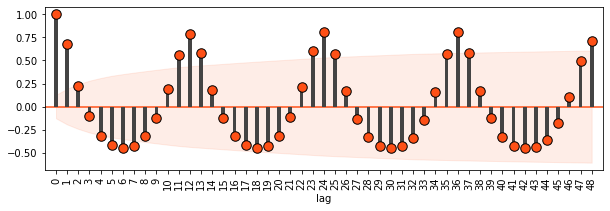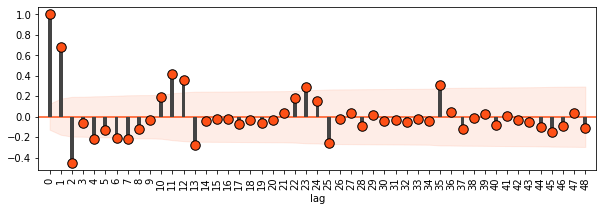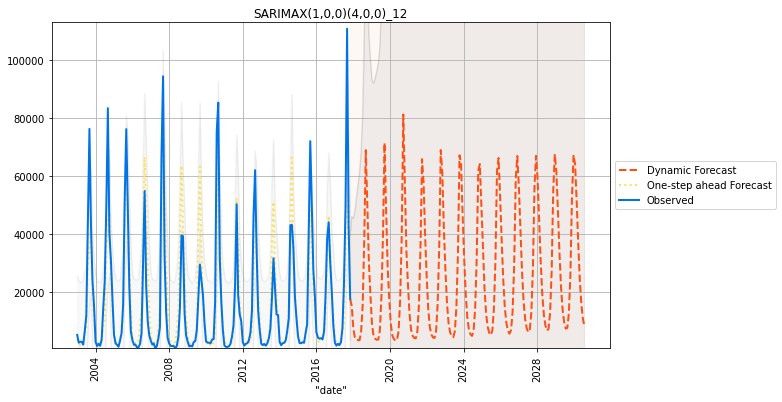Time Series#
Time series models are a type of regression on a dataset with a timestamp label.
The following example creates a time series model to predict the number of forest fires in Brazil with the ‘Amazon’ dataset.
[7]:
from verticapy.datasets import load_amazon
amazon = load_amazon().groupby("date", "SUM(number) AS number")
display(amazon)
📅 dateDate | 123 numberInteger | |
| 1 | 1998-01-01 | 0 |
| 2 | 1998-02-01 | 0 |
| 3 | 1998-03-01 | 0 |
| 4 | 1998-04-01 | 0 |
| 5 | 1998-05-01 | 0 |
| 6 | 1998-06-01 | 3551 |
| 7 | 1998-07-01 | 8066 |
| 8 | 1998-08-01 | 35549 |
| 9 | 1998-09-01 | 41968 |
| 10 | 1998-10-01 | 23495 |
| 11 | 1998-11-01 | 6804 |
| 12 | 1998-12-01 | 4448 |
| 13 | 1999-01-01 | 1081 |
| 14 | 1999-02-01 | 1284 |
| 15 | 1999-03-01 | 667 |
| 16 | 1999-04-01 | 717 |
| 17 | 1999-05-01 | 1812 |
| 18 | 1999-06-01 | 3632 |
| 19 | 1999-07-01 | 8756 |
| 20 | 1999-08-01 | 39486 |
| 21 | 1999-09-01 | 36913 |
| 22 | 1999-10-01 | 27012 |
| 23 | 1999-11-01 | 8860 |
| 24 | 1999-12-01 | 4376 |
| 25 | 2000-01-01 | 778 |
| 26 | 2000-02-01 | 561 |
| 27 | 2000-03-01 | 848 |
| 28 | 2000-04-01 | 537 |
| 29 | 2000-05-01 | 2097 |
| 30 | 2000-06-01 | 6275 |
| 31 | 2000-07-01 | 4739 |
| 32 | 2000-08-01 | 22202 |
| 33 | 2000-09-01 | 23291 |
| 34 | 2000-10-01 | 27336 |
| 35 | 2000-11-01 | 8399 |
| 36 | 2000-12-01 | 4465 |
| 37 | 2001-01-01 | 547 |
| 38 | 2001-02-01 | 1059 |
| 39 | 2001-03-01 | 1268 |
| 40 | 2001-04-01 | 1081 |
| 41 | 2001-05-01 | 2090 |
| 42 | 2001-06-01 | 8433 |
| 43 | 2001-07-01 | 6490 |
| 44 | 2001-08-01 | 31887 |
| 45 | 2001-09-01 | 39834 |
| 46 | 2001-10-01 | 31038 |
| 47 | 2001-11-01 | 15639 |
| 48 | 2001-12-01 | 6201 |
| 49 | 2002-01-01 | 1654 |
| 50 | 2002-02-01 | 1570 |
| 51 | 2002-03-01 | 1679 |
| 52 | 2002-04-01 | 1682 |
| 53 | 2002-05-01 | 3818 |
| 54 | 2002-06-01 | 10839 |
| 55 | 2002-07-01 | 13751 |
| 56 | 2002-08-01 | 57151 |
| 57 | 2002-09-01 | 55803 |
| 58 | 2002-10-01 | 47722 |
| 59 | 2002-11-01 | 28179 |
| 60 | 2002-12-01 | 11944 |
| 61 | 2003-01-01 | 5091 |
| 62 | 2003-02-01 | 2398 |
| 63 | 2003-03-01 | 2749 |
| 64 | 2003-04-01 | 2677 |
| 65 | 2003-05-01 | 1747 |
| 66 | 2003-06-01 | 6506 |
| 67 | 2003-07-01 | 11804 |
| 68 | 2003-08-01 | 43736 |
| 69 | 2003-09-01 | 76325 |
| 70 | 2003-10-01 | 43295 |
| 71 | 2003-11-01 | 23572 |
| 72 | 2003-12-01 | 15342 |
| 73 | 2004-01-01 | 2705 |
| 74 | 2004-02-01 | 1255 |
| 75 | 2004-03-01 | 2040 |
| 76 | 2004-04-01 | 1335 |
| 77 | 2004-05-01 | 3535 |
| 78 | 2004-06-01 | 14262 |
| 79 | 2004-07-01 | 23809 |
| 80 | 2004-08-01 | 49325 |
| 81 | 2004-09-01 | 83500 |
| 82 | 2004-10-01 | 40331 |
| 83 | 2004-11-01 | 30763 |
| 84 | 2004-12-01 | 17524 |
| 85 | 2005-01-01 | 4990 |
| 86 | 2005-02-01 | 2153 |
| 87 | 2005-03-01 | 1706 |
| 88 | 2005-04-01 | 1011 |
| 89 | 2005-05-01 | 3210 |
| 90 | 2005-06-01 | 5811 |
| 91 | 2005-07-01 | 15663 |
| 92 | 2005-08-01 | 51981 |
| 93 | 2005-09-01 | 76257 |
| 94 | 2005-10-01 | 49876 |
| 95 | 2005-11-01 | 21752 |
| 96 | 2005-12-01 | 6354 |
| 97 | 2006-01-01 | 3255 |
| 98 | 2006-02-01 | 1666 |
| 99 | 2006-03-01 | 1774 |
| 100 | 2006-04-01 | 792 |
The feature ‘date’ tells us that we should be working with a time series model. To do predictions on time series, we use previous values called ‘lags’.
To help visualize the seasonality of forest fires, we’ll draw some autocorrelation plots.
[8]:
amazon.acf(ts = "date",
column = "number",
p = 48)
amazon.pacf(ts = "date",
column = "number",
p = 48)
[8]:
| value | confidence | |
| 0 | 1.0 | 0.12677953091477837 |
| 1 | 0.680791943478559 | 0.17635811053763537 |
| 2 | -0.448651760602 | 0.19431587020757396 |
| 3 | -0.056810938511524 | 0.1949967219550794 |
| 4 | -0.214072572565421 | 0.19920783402950895 |
| 5 | -0.132275379180003 | 0.20106670828355816 |
| 6 | -0.209271515399161 | 0.20504977108289735 |
| 7 | -0.22086005226401 | 0.20938483891715817 |
| 8 | -0.115381512422639 | 0.21088997523164357 |
| 9 | -0.0303897676702676 | 0.21142090542967373 |
| 10 | 0.195940057811936 | 0.21490010161856166 |
| 11 | 0.421096854695467 | 0.2288227396007685 |
| 12 | 0.354085600891183 | 0.23839868796477473 |
| 13 | -0.277539454272164 | 0.24434402010546988 |
| 14 | -0.0466619873562256 | 0.2450381591011353 |
| 15 | -0.0252179360480865 | 0.2456289146925101 |
| 16 | -0.0208627356674878 | 0.2462094909416231 |
| 17 | -0.0738925038464602 | 0.24714597766954416 |
| 18 | -0.0277152168151683 | 0.24775839671186392 |
| 19 | -0.0570139111880927 | 0.2485493119105585 |
| 20 | -0.0359062473532943 | 0.24920689325929707 |
| 21 | 0.0368926532844579 | 0.2498738171394672 |
| 22 | 0.183517089844233 | 0.25281820622976037 |
| 23 | 0.290406504204887 | 0.25925413775321304 |
| 24 | 0.148748898561334 | 0.2613732869695089 |
| 25 | -0.252848551418073 | 0.2663277988831778 |
| 26 | -0.0207691117701225 | 0.26698138981979946 |
| 27 | 0.0353140856274143 | 0.2676947498028233 |
| 28 | -0.0921054257296545 | 0.26890332746753587 |
| 29 | 0.0154355178357686 | 0.2695589819239979 |
| 30 | -0.0390214624263903 | 0.2703066482776497 |
| 31 | -0.0361906130217691 | 0.2710449043780445 |
| 32 | -0.0476484001557326 | 0.27185384167555554 |
| 33 | -0.0190915628486309 | 0.2725378227507442 |
| 34 | -0.0448275804550625 | 0.2733395375351199 |
| 35 | 0.311750035943525 | 0.28060824273716456 |
| 36 | 0.0433932016985829 | 0.2814251891164287 |
| 37 | -0.115879309798946 | 0.28302463030064584 |
| 38 | -0.0134882291090413 | 0.2837400527560789 |
| 39 | 0.0304452233355777 | 0.28451110093290016 |
| 40 | -0.0850278455500817 | 0.28571394104765774 |
| 41 | 0.00500894018005289 | 0.2864362316089425 |
| 42 | -0.0359016190911242 | 0.2872498182295229 |
| 43 | -0.0515636004698935 | 0.288162560585811 |
| 44 | -0.102742842573654 | 0.2896194072202406 |
| 45 | -0.147438988566255 | 0.29184355740744294 |
| 46 | -0.0890791253319279 | 0.2931379370389525 |
| 47 | 0.037269291025163 | 0.2939948682267675 |
| 48 | -0.108829668970081 | 0.2955705134853683 |


Forest fires follow a predictable, seasonal pattern, so it should be easy to predict future forest fires with past data.
VerticaPy offers several models, including a multiple time series model. For this example, let’s use a SARIMAX model.
[10]:
from verticapy.learn.tsa import SARIMAX
model = SARIMAX("SARIMAX_amazon",
p = 1,
d = 0,
q = 0,
P = 4,
D = 0,
Q = 0,
s = 12)
model.fit(amazon,
y = "number",
ts = "date")
[10]:
=======
details
=======
# Coefficients
predictor coefficient
1 Intercept 157.796898394296
2 ar1 0.227469801171249
3 ar12 0.223437485648028
4 ar24 0.332300398258616
5 ar36 0.323432558611675
6 ar48 -0.0577341008764085
Rows: 1-6 | Columns: 2
===============
Additional Info
===============
Input Relation : (SELECT "date", "number" FROM (SELECT "date", SUM(number) AS number FROM "public"."amazon" GROUP BY 1) VERTICAPY_SUBTABLE) VERTICAPY_SUBTABLE
y : "number"
ts : "date"
Just like with other regression models, we’ll evaluate our model with the report() method.
[11]:
model.report()
[11]:
| value | |
| explained_variance | 0.722933514390621 |
| max_error | 62492.5846405041700760 |
| median_absolute_error | 1926.16510474475 |
| mean_absolute_error | 6244.63330879244 |
| mean_squared_error | 124238623.160803 |
| root_mean_squared_error | 11146.238072139093 |
| r2 | 0.722927644647118 |
| r2_adj | 0.7149197731051271 |
| aic | 3348.6392952754804 |
| bic | 3367.2752380175016 |
We can also draw our model using one-step ahead and dynamic forecasting.
[12]:
model.plot(amazon,
nlead = 150,
dynamic = True)
[12]:
<AxesSubplot:title={'center':'SARIMAX(1,0,0)(4,0,0)_12'}, xlabel='"date"'>

This concludes the fundamental lessons on machine learning algorithms in VerticaPy.